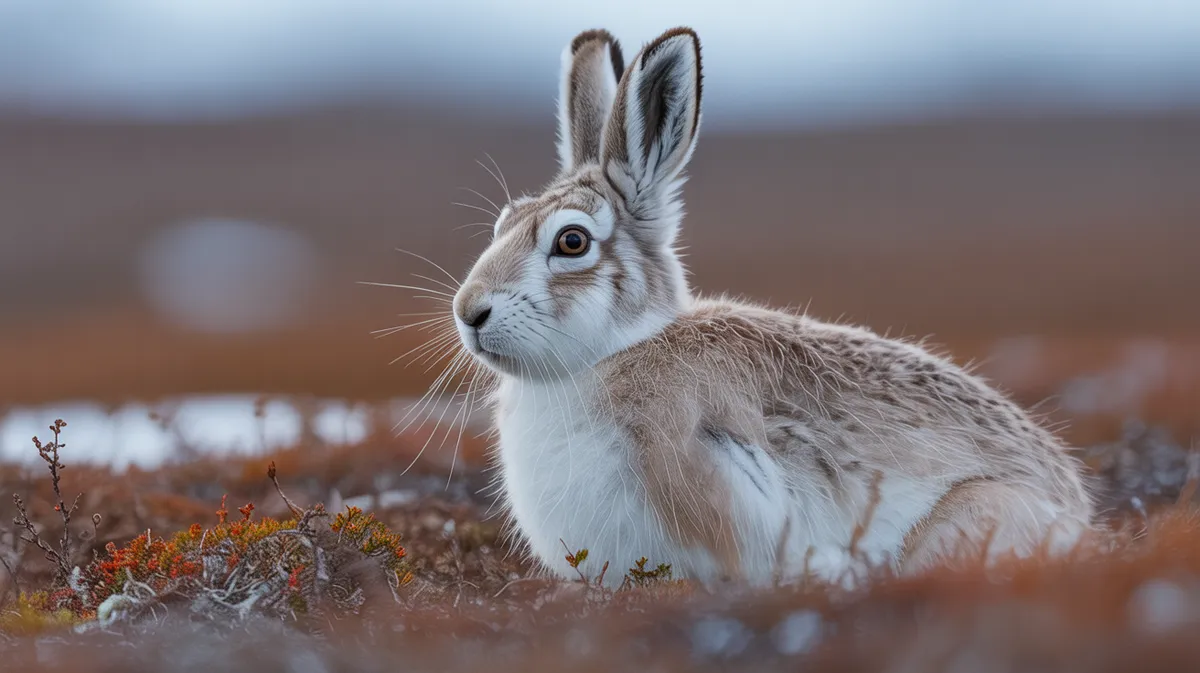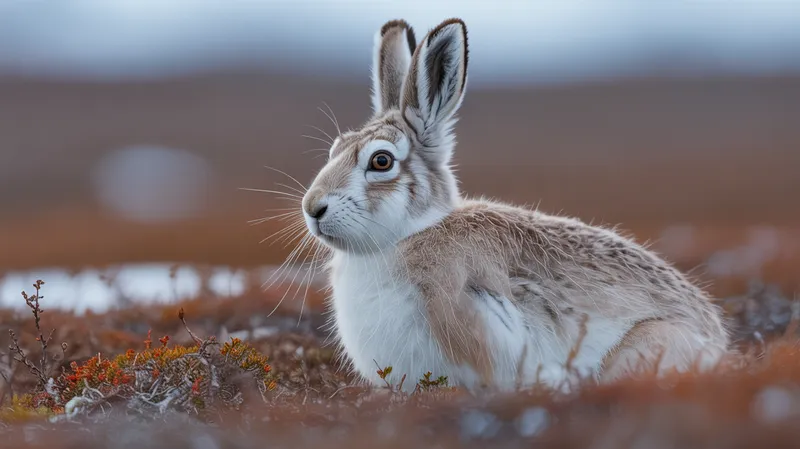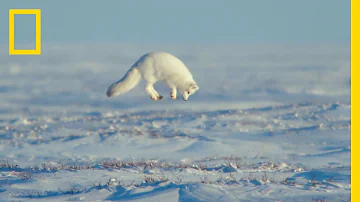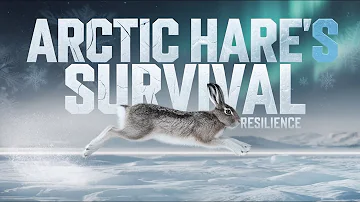
Arctic Hare
Lepus arcticus

Meet the Arctic Hare
The Arctic Hare is a hardy mammal adapted to the extreme cold of the Arctic tundra. With its thick white fur, it blends seamlessly into snowy landscapes, providing excellent camouflage from predators. It has powerful hind legs that allow it to travel swiftly across snow and escape danger. This species can survive in some of the harshest conditions on Earth, relying on its keen senses and behavioral adaptations to find food and shelter.
Classification
Mammal
Habitat
Arctic tundra
Diet
Herbivore
Lifespan
3-5 years
Conservation
Least Concern
Weight
2.5–5.5 kg
📖Fascinating Facts
Cold Weather Expert
The Arctic Hare’s dense fur and compact body shape help it conserve heat, making it perfectly suited for freezing Arctic climates.
Snow Sprint
This hare uses its strong hind legs to leap great distances and can reach speeds up to 60 km/h to escape predators like Arctic foxes and wolves.
Winter Forager
Even in winter, Arctic Hares dig through snow to find roots, woody plants, and mosses, demonstrating remarkable survival skills.
📋Detailed Description
The Arctic hare (Lepus arcticus) is a robust lagomorph uniquely adapted to the extreme cold and open landscapes of the Arctic tundra. Adults typically measure 43–70 cm (17–28 in) in length, with a tail of 4–8 cm (1.6–3.1 in), and weigh between 2.5–7 kg (5.5–15.4 lbs), with northern individuals tending to be larger. Its dense, white winter coat provides both insulation and camouflage against snow, while a seasonal molt results in a blue-gray or brownish summer pelage in some southern populations. The hare's ears are notably shorter than those of other Lepus species, minimizing heat loss, and its powerful hind legs are adapted for rapid, bounding locomotion across snow and ice. Arctic hares are primarily crepuscular, being most active during dawn and dusk, and exhibit both solitary and gregarious behaviors, sometimes forming groups of up to several hundred individuals. Their diet consists mainly of woody plants, mosses, lichens, and occasionally berries and seaweed, with a digestive system capable of extracting nutrients from fibrous, low-quality forage. They are known for digging shelters in snowbanks or ground hollows to escape predators and harsh weather. The species is an important prey item for Arctic foxes, wolves, and birds of prey, and plays a key role in tundra food webs. Arctic hares possess acute senses of hearing and smell, aiding in predator detection and foraging under snow cover.
💡 Did you know?
Despite living in icy environments with little vegetation, Arctic Hares can dig through snow to find woody plants, mosses, and lichens to eat.
🔬Research & Sources
Wikipedia Summary
The Arctic hare is a species of hare highly adapted to living in the Arctic tundra and other icy biomes. The Arctic hare survives with shortened ears and limbs, a small nose, fat that makes up close to 20% of its body, and a thick coat of fur. It usually digs holes in the ground or under the snow to keep warm and to sleep. Arctic hares look like rabbits but have shorter ears, are taller when standing, and, unlike rabbits, can thrive in extreme cold. They can travel together with many other hares, sometimes huddling with dozens or more, but are usually found alone, sometimes taking more than one partner. The Arctic hare can run up to 60 kilometres per hour (40 mph).
Last Modified: 5/24/2025
🎭Behavior & Social Structure
Arctic hares are generally solitary but may aggregate in large groups, particularly during winter, which may serve to reduce predation risk and conserve heat. They are highly vigilant and rely on their keen senses to detect threats, often freezing motionless to avoid detection or fleeing at speeds up to 60 km/h (37 mph) when pursued. Feeding occurs primarily at ground level, with hares using their strong forelimbs to dig through snow for food. They exhibit coprophagy, re-ingesting soft fecal pellets to maximize nutrient absorption. Daily routines are influenced by light availability and temperature, with increased activity during twilight hours. Social interactions are limited outside of the breeding season, though temporary pair bonds may form. Aggressive encounters are rare but may occur over territory or mates.
👶Reproduction & Life Cycle
Breeding occurs from late April to early July, depending on latitude and snowmelt. Arctic hares are generally polygynous, with males competing for access to females. After a gestation period of approximately 50 days, females give birth to a single litter per year, typically consisting of 2–8 leverets (young hares). Leverets are born fully furred and with eyes open, a trait known as precocial development, and are hidden in shallow ground nests called forms. Maternal care is limited to brief nursing visits, reducing the risk of attracting predators. Weaning occurs at 2–3 weeks, and juveniles become independent soon after. Sexual maturity is reached at about one year of age.
🛡️Adaptations & Survival
The Arctic hare displays a suite of physiological and behavioral adaptations for Arctic survival. Its compact body, short ears, and limbs minimize surface area and heat loss, while a thick subcutaneous fat layer (up to 20% of body mass) provides insulation and energy reserves. The hare's fur undergoes seasonal color changes for camouflage, and its feet are wide and densely furred, functioning as snowshoes. Behavioral adaptations include burrowing into snow for shelter, huddling in groups for warmth, and reduced activity during extreme cold. Its digestive system is specialized for extracting nutrients from tough Arctic vegetation, and its reproductive strategy ensures young are born during the brief summer window.
🎨Cultural Significance
The Arctic hare holds significance for Indigenous peoples of the Arctic, including the Inuit, who have traditionally hunted it for food and used its fur for clothing and bedding. In folklore, the hare is sometimes associated with agility, survival, and adaptability. Its presence in the tundra ecosystem is also reflected in local art and storytelling. While not as prominent in global mythology as the Arctic fox or polar bear, the hare is a symbol of the resilience of Arctic wildlife.
🔬Recent Research & Discoveries
Recent research has focused on the genetic diversity and population structure of Arctic hares across their range, revealing distinct subspecies and adaptations to local environments. Studies using GPS tracking have provided insights into seasonal movements, habitat use, and group dynamics. Ongoing research examines the impacts of climate change on hare distribution, reproductive timing, and predator-prey relationships. There is also growing interest in the hare's role as an indicator species for ecosystem health in the rapidly changing Arctic.
🎥Wildlife Videos

Wildlife in the Frozen Forest (Full Episode) | Wild Arctic | Nat Geo Animals
In a forest of a trillion trees, the planet's most resilient species must find ingenious ways to survive one of nature's most brutal ...
Nat Geo Animals

The Unsung Heroes of the Arctic - Ep. 3 | Wildlife: The Big Freeze
Polar bears dominate the Arctic animal headlines; it's hard for anything to escape their shadow. In this episode we meet an ...
National Geographic

Arctic Hare
Hi Everyone. Wildlife All About lets you explore and provides Information about different types of animals. It helps you to learn ...
Wildlife All About

How Arctic Hares Came To Rule The North Pole
For Arctic Hares there's nothing better than being an orb. Support Animalogic on Patreon: https://www.patreon.com/animalogic ...
Animalogic

The Resilient Life of the Arctic Hare
... cycle of the Arctic hare, Arctic hares and their habitat, Arctic nature documentaries and facts, conservation of Arctic wildlife and ...
Animal Insights

ARCTIC PREDATOR | The Unsung Heroes of the Arctic | Nature Animal Documentary
ARCTIC PREDATOR | The Unsung Heroes of the Arctic | Nature Animal Documentary The Arctic! The second most unforgiving ...
Nature's Moments
🌍Habitat Information
The Arctic Hare typically inhabits Arctic tundra environments. Arctic Hares have adapted to their environments with specialized features and behaviors.
Primary Habitat:
Arctic tundra
More detailed habitat information will be available soon.
🛡️Conservation Status
The Arctic Hare is currently classified as Least Concern. Conservation efforts are crucial for preserving this species for future generations.
Common Threats:
- 🏠Habitat loss and fragmentation
- 🌡️Climate change impacts
- 🎯Hunting and poaching
- 🏭Human-wildlife conflict
⚠️Threats & Conservation Challenges
Currently, the Arctic hare is classified as Least Concern by the IUCN due to its wide distribution and large population. However, climate change poses a significant long-term threat by altering tundra habitats, affecting snow cover, and shifting plant communities. Increased predation pressure from expanding populations of red foxes and other predators, as well as potential competition with introduced species, are additional concerns. Human activities, such as mining and resource extraction in the Arctic, may impact local populations. Despite these challenges, the species remains relatively stable, but continued monitoring is necessary.
🔬Scientific Classification
Scientific Name
Lepus arcticus
Classification Hierarchy
🔍 About Taxonomic Classification
Taxonomic classification is a hierarchical system used by scientists to classify and organize living organisms based on shared characteristics and evolutionary relationships.
The system moves from broad categories (Kingdom) to increasingly specific ones, with each animal's scientific name typically consisting of its Genus and species.
📝Community Notes
Share your observations and insights about the Arctic Hare with our community of wildlife enthusiasts.
Join Our Community
Sign in to share your observations and connect with fellow wildlife enthusiasts.
Sign In to ContributeNo community notes yet
Be the first to share your observations about the Arctic Hare!
Explore Arctic Hare
Select a tab above to learn more about this amazing animal.
📸Photo Gallery
No photos available for this animal yet.
🌟Discover More Wildlife
Continue your journey of discovery with more fascinating animals from our database
